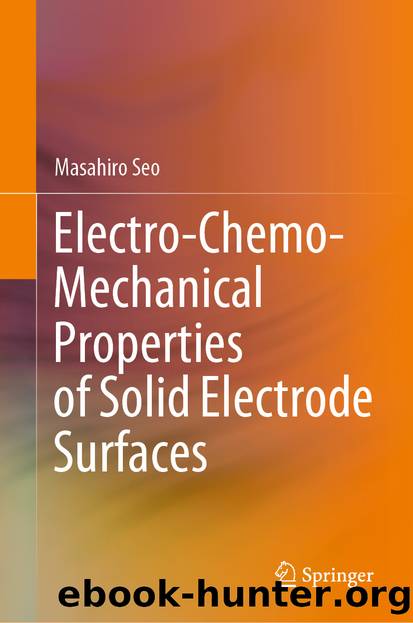Electro-Chemo-Mechanical Properties of Solid Electrode Surfaces by Masahiro Seo

Author:Masahiro Seo
Language: eng
Format: epub
ISBN: 9789811572777
Publisher: Springer Singapore
The intersection of two extrapolated lines in the linear (I) and (III) domains at may be regarded as the onset of the Pb-UPD. The cathodic charge density at the cathodic limit potential of â0.24 V (SHE) is . If the Pb-UPD monolayer is formed at â0.24 V (SHE), the cathodic charge density required for the monolayer formation is . The atomic density of an atomically flat Au (111) surface without reconstruction is 1.38âÃâ1019 atoms mâ2. Assuming the complete discharging of Pb2+ (i.e., ), and the hexagonal close-packed (hcp) Pb monolayer, and taking the difference in radius between Pb () and Au () atoms into account [12], the cathodic charge density required for the formation of the Pb-UPD monolayer on an atomically flat Au (111) surface is . If the surface roughness of the (111)-textured Au film electrode is , the experimental value of in Fig. 4.4 is close to that theoretically derived.
The surface coverage of Pb on the top abscissa of Fig. 4.4 is calculated from the cathodic charge density by regarding as at â0.24 V (SHE). The plateau (IV) domain with the hump of surface stress associated with the structural change of the Pb-UPD layer corresponds to . Stafford and Bertocci [13] also measured the changes in surface stress as a function of on a (111)-textured Au thin-film electrode in 0.1 M HClO4 solution with 10â2 M Pb (ClO4)2 and observed the same plateau (IV) domain at . According to Stafford and Bertocci [13], the values of determined by using an electrochemical quartz microbalance (EQCM) in separated experiments were in good agreement with the coulometric results. The average value of at the plateau (IV) domain deviates each other by , which may result from the difference in ionic strength or activity of Pb2+ between the electrolytes used for experiments [12, 13].
According to surface X-ray scattering (SXS) study of the Pb-UPD on Au (111) electrode by Toney et al. [23], the Pb-UPD monolayer with compressive and incommensurate hcp structure is rotated from the gold substrate direction by at potentials lower than â0.11 V (SHE), but not rotated (i.e., ) at potentials higher than â0.08 V (SHE). The humps of surface stress in Fig. 4.3 were initially ascribed to the relaxation of compressive surface stress caused by the rotation of the incommensurate hcp structure from to 2.5° [10â12]. Nevertheless, Stafford and Bertocci [13] claimed that the stress hump is not associated with the rotation of the incommensurate hcp monolayer but with the coalescence of the hcp Pb islands since the potential at which the rotation of the incommensurate hcp monolayer takes place is more negative by about 0.07 V than the potential at which the surface stress hump is observed. The more detailed study by Shin et al. [15] implied that the stress hump is associated with the phase transformation between the incommensurate hcp monolayer and surface alloy of . Scanning tunnel microscopic (STM) observation during Pb-UPD on Au (111) [24] indicated that the hcp Pb islands are slowly transformed to the alloy structure of only at a low coverage of Pb, .
Download
This site does not store any files on its server. We only index and link to content provided by other sites. Please contact the content providers to delete copyright contents if any and email us, we'll remove relevant links or contents immediately.
Sapiens: A Brief History of Humankind by Yuval Noah Harari(14006)
The Tidewater Tales by John Barth(12414)
Mastermind: How to Think Like Sherlock Holmes by Maria Konnikova(6956)
Do No Harm Stories of Life, Death and Brain Surgery by Henry Marsh(6699)
The Thirst by Nesbo Jo(6473)
Why We Sleep: Unlocking the Power of Sleep and Dreams by Matthew Walker(6391)
Life 3.0: Being Human in the Age of Artificial Intelligence by Tegmark Max(5211)
Sapiens by Yuval Noah Harari(5137)
The Longevity Diet by Valter Longo(4872)
The Body: A Guide for Occupants by Bill Bryson(4618)
The Rules Do Not Apply by Ariel Levy(4551)
The Immortal Life of Henrietta Lacks by Rebecca Skloot(4274)
Why We Sleep by Matthew Walker(4205)
Animal Frequency by Melissa Alvarez(4182)
Yoga Anatomy by Kaminoff Leslie(4117)
The Hacking of the American Mind by Robert H. Lustig(4111)
All Creatures Great and Small by James Herriot(4009)
Double Down (Diary of a Wimpy Kid Book 11) by Jeff Kinney(3959)
Barron's AP Biology by Goldberg M.S. Deborah T(3954)
